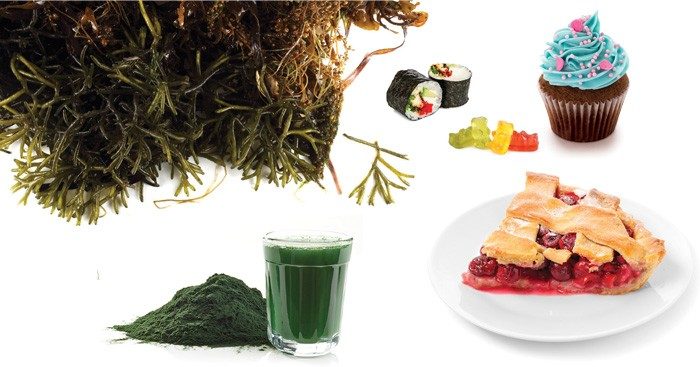By Robin Tanke

Which of the following foods contain algae?
Ice Cream • Cherry Pie • Sushi Roll • Spirulina Drink • Icing • Candy
Read this article to find out about these foods and more!
There are basically four types of algae, based on their color: green, blue-green, red, and brown. Green and blue-green algae are found in freshwater as well as saltwater. Red and brown algae are found only in saltwater and are also called seaweed.
Did you know that algae of all four types have been a food source for people for at least 14,000 years? For example, the Man'yōshū, a 1,200-year-old collection of poems about everyday life in Japan, describes people gathering seaweed at low tide. The poem also calls seaweed “precious since the age of the gods.”
On the other side of the world, the Aztec peoples, who lived in what is now Central Mexico, harvested blue-green algae from the surface of lakes using ropes. They ate dried algae with tortillas and toasted corn and sometimes made sauce with algae. Later, English colonists brought to North America a pudding they prepared by boiling red algae with milk. Today, we find algae in our food, in both ordinary and unexpected places.
Red algae, especially nori, are dried and then used as a wrap for making sushi or added to soups, salads, sandwiches, and even baked goods. Although it may appear to be simply a convenient edible cover, nori contains protein, fiber, healthy fats, and vitamins (even more than soybeans!). In addition to being used in dried form, products such as agar and carrageenan are extracted (or taken out) from red algae. These products are used to make gels or thick creamy foods such as pie fillings, cake frostings, sherbets, and custards.
Brown algae, especially kelp, are used to extract another gel-forming product called algin. Algin absorbs water to make gels and thick solutions and can be found in ice creams and dry baking mixes.
Blue-green algae, especially spirulina, are an important protein source. In areas where food is not easily available, they are a valuable protein source and contain healthy fats, as well as certain important vitamins and minerals. For people who avoid eating animal products, algae can be an important source of vitamin B12. Additionally, spirulina’s lovely color is used to make candy, ice cream, and blue gum.
Algae are used in a variety of ways in making food, from coloring, to wrapping, to gel-forming … and also as sources of healthy nutrients. Next time you eat ice cream, candy, gum, or sushi, you should check to see if it has any algae in it!
And to answer the question at the beginning of this article: Which of the foods above contain algae? All of them do!
Robin Tanke is Professor of Chemistry, University of Wisconsin-Stevens Point.

